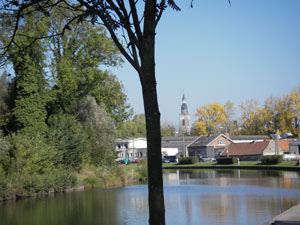|
|
|
From Antoing to Paris |
||
|
We crossed the border to France on the 12th October. The thought of the French language did cross our minds. The French are not known for speaking English and our knowledge of French … well , it is what it is. But, what we encountered were very nice and friendly people who wanted to help in any way they could. The leg to Paris turned out to be a very pleasant one. There was a little bit of drama all the same… (Our camera battery ran out and unfortunately we couldn´t get it charged until we got to Cambrai) It was a misty morning on the 12th October when we got up. We waited for a few hours and the mist started to lift. We cast off while our Belgian friends waved good bye. “Promise to stay in the middle – there are lots of stones on the sides” they shouted. We promised as we left. Even though the mist was lifting there were a few fog banks about. We went into a fog bank and we saw the strangest constellation of buoys. Greens, reds and yellows. It looked as if the greens were in the middle of the canal. Reds and yellows on both banks. Now which side of the greens were we going to go? An easy question for experienced seafarers – or? Green on starboard side and red on the port side in the direction of the fareway. How is it in a canal? Well, green on port and red on starboard side downstream. Were we going upstream or downstream? The water was like a mirror and we couldn´t find any information in our instructions. Time to make a decision. Geographically we were traveling down, so we decided that we were going downstream and carried on with the green buoys on the port side. We carried on happily straight into the mud. And we were stuck fast! As much as we tried we didn´t get anywhere. We also realized that nobody could get in close enough to help us. A barge slowed down when passing and promised to talk to other barges to slow down and help us. We were just pumping up our rubber dinghy so that we could row out a rope. As we were launching our dinghy we saw a barge coming. Mike rowed out with the rope and was waiting for the barge. Everything went very smoothly. The barge slowed down, tied the dinghy to the barge and took the towing rope and fastened it. The barge had to rev the engine quite a bit to get us free and it wasn´t until our boat was on the other side of the greens that I could move the rudder. We were off! We have heard a lot of stories about barges and their owners – but our encounters with them have been nothing but positive. Not to mention this latest rescue mission! Well, what is the lesson we learnt from this? That we always have to know whether we are going up- or downstream! No more mishaps this day… At the Fresnes lock we “checked in” into French territorial waters. What they requested to see was our certificate (Swedish Yachting Association) and they wanted to know where we were going. Here we also got a form to show later when we paid our vinjett/péage (fee) in St. Quentin. How did we manage with the language? They didn´t speak any English at all, but we managed to understand each other quite well. They were nice too… By the evening we had got as far as the lock Etrun where we moored for the night. The next morning we got a lesson in how to get through the remote controlled locks. This is a system introduced to smaller canals. We got a remote control. It looked just like one for a TV. The difference was that there were fewer buttons to push. You were either on your way up or down. We were now on our way up! About 100-150 meters from the lock there was a sign which said “Signal”. There you pointed your remote control towards the lock and pressed the button – once. The red/green signal lit and we waited for the green signal and the lock to open. The signal changed to green and we went in and tied up. The difference in height in these locks was about 2 meters. On the lock wall there were two vertical rods – one blue and one read – we pushed up the blue one (about 1 dm) and the lock gate closed. After a while the water level started to rise. When we had reached the correct level a bell started to ring. The gate on the other side opened. We untied the boat and went through. When we had got a distance away the gates closed behind us. There were no lock-keepers anywhere. Everything was handled by us with the help of electronics, sensors and radar. A very effective system indeed. Should we get into trouble we could contact a central either by telephone, VHF or an intercom system at the lock. One could also push the red rod and thus close the whole system down if there was an emergency. In our guide book “Inland Waterways of France” we read about how VNF (Voies Navigables de France), a public company established 1991, got the task of running the canals on a commercial basis. A part of this has been to organize a more effective system for the locks. We had many and good contacts with VNF personnel during our trip. Working the locks went very well and we had a very pleasant day. We decided on a short day because we were told that the Riqueval tunnel would be closed at the weekend. We carried on to Cambray and stayed the weekend there. The experience of traveling along this canal can only be described as fantastic. An excerpt from our log book: “The trip there was all that you could imagine that canalling was all about”.
|
||
|
When we got to Cambrai the guest harbour was situated in something that could be described as a lagoon. One bank of it was occupied by fishermen and the other by all different kind of boats. We got the last boat place there. Most of the boats were British ones wintering in France. We got a lot of information from them about where the nearest shops were, etc. A little bit of gossip as well, such as the feud going on between the fishermen and the guest harbour owners. The fishermen don´t want any boats there at all…and the feud continues.
|
 |
|
|
On the Saturday there was the Worldcup rugby semifinals between England and France being played in Paris. This you could see on the balconies with French flags hanging on them. In the evening the match was going to be shown at the local bar and the Brits were going there. We chose to listen to the BBC World Service instead. But we heard the Frenchmen though, during the first part of the game. Then it was very quiet... England won and later they were going to meet South Africa.
|
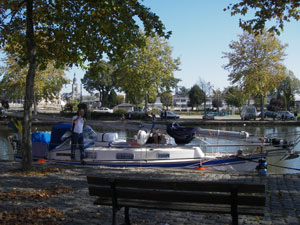 |
|
|
Sunday was a brilliant Autumn day with the whole of Cambray out strolling – it looked like it. We also went out walking – along the canal, of course. We went to bed quite early as we wanted to get away in good time the next day. The only thing keeping us awake was the rats running along the quay at night…
|
|
|
|
Canal de St. Quentin starts at Cambray and ends in Chauny. It is 93 km long and has 35 locks and two tunnels. We had brilliant sunshine and were almost on our own on the canal. This was an advantage when we were going through the locks. In one day we went through 17 locks and Riqueval tunnel. It would have taken a lot longer had there been more traffic. As it was we were sharing the canal with a couple of barges – that´s all.
|
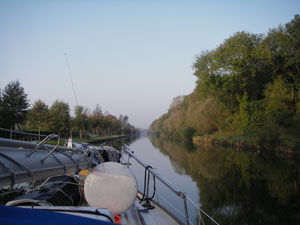 |
|
|
Riqueval tunnel was quite fantastic! It is 5 670 meters long, takes 2,5 hours to get through and we had to be towed by a tug. The tug was electric and was pulled along a chain on the bottom of the canal. The tunnel was constructed during Napoleonic times, i.e. in the middle of 17th century, and is incredibly straight all the way through.
|
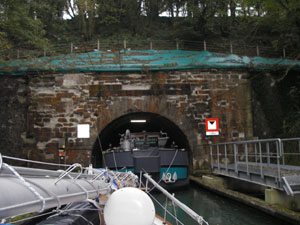 |
|
|
The fee of €21 was going to be invoiced so we didn´t have to think about money at the entrance of the tunnel. The experience was not as claustrophobic as I thought it would be. It was cold, though. Every ten meters there was a sign telling you how far you had traveled…
|
|
|
|
When we had passed through the tunnel we made our way to the next one, the tunnel of Lesdin. This one was “only” about 700 meters long. Now it was getting really dark and we didn´t see any light signal at the tunnel entrance. We therefore decided to moor and carry on the following day.
|
 |
|
|
After breakfast we heard somebody outside the boat. We peered out and saw a man with VNF written on his jacket. He politely said “Bonjour!”. He also told us he was there for our safety. He seemed to know exactly who we were and where we were heading and explained to us that there was a boat coming out of the tunnel. As soon as that one had passed us we could carry on through the tunnel. All we saw along the canal were trees and bushes – no dwelling places at all. Could there be cameras set up along the way…? All the communication took place in French and of course body language!
|
 |
|
|
Lesdins tunnel and four locks later we got to Saint Quentin and Port de Plaisance (the Guest Harbour). As we were there at 11 a.m. it felt really luxurious to have the best part of the day in front of us. When we had checked in we thoroughly cleaned the boat inside and out. She was really dirty after going through all the locks and it was nice to have a clean boat again. Then it was time to do some food shopping. The first information you get is where you can find a “Boulangerie”, i.e. a baker´s shop. The next is “Boucherie”, i.e. the butcher ´s and then you got the instructions to the supermarket. It takes a while to walk to all the different places and Mike´s Christmas present from work comes in very handy. It is a rucksack that you can convert into a trolleybag. Perfect!
|
 |
|
|
Here in Saint Quentin we also paid our vinjett/péage (fee) to travel on the French Inland Waterways. We jumped on our bikes and found our way to the VNF office. When we got there they greeted us with: “You are coming to pay your vinjett”. It felt as if they were expecting us and also recognized us. Here we showed the form we received at Fresnes, our international certificate and also paid the fee of €210,10 for the rest of the year. Earlier we have been used to paying a fee based on the length of the boat – this time we had to pay a fee based on the square meter surface of the boat. Instead of 9,36 m it was now 26,86 m2. After Saint Quentin the locks started to go downward. This meant a more leisurely existence and we reached Chauny in the afternoon of the 18th October. |
 |
|
|
We planned to stay only the one night, but when we saw the washing machine in the guest harbour, we decided to stay an extra day and do some general maintenance, i.e. the laundry, repairing the zip on the canopy and also having my hair cut. With the dictionary at the ready I got a haircut, which I was very pleased with and a few more French words to add to the vocabulary… In the meantime Mike was working on the engine... |
 |
|
|
Chauny is a small, picturesque town with small shops and they had a market the day we were there.
|
 |
|
|
I went to the butchers to get something for dinner and saw through the window that it was quite crowded. I have time to wait, I thought, and went in. Everybody in the shop turned round and said “Bonjour Madame!” I turned around to see who had come in behind me – but there was nobody. With a little bit more colour to my cheeks I turned around and greeted everybody with a “Bonjour!” back. It felt very welcoming. We might have stayed the winter here...
|
 |
|
|
The barometer was on its´ way up and we were looking forward to more sunshine for the next few days. Clear nights also meant colder nights so it was time to dig out our hot water bottles!
|
|
|
|
After Chauny we entered the river Oise. Even though there are locks, it is completely different traveling along a river compared to a canal. The leg to the lock Sarron at Pont-Sainte-Maxenne was very beautiful and we enjoyed it to the full. As we got there a helpful barge owner caught our mooring lines and helped us tie up for the night.
|
 |
|
|
It was a clear evening and we were sitting around the radio listening to the BBC World Service and the final of the rugby between England and South Africa. England lost 15 – 6, but as the French say: “C´est la vie!” We blew out our candles and went to bed (with the hot water bottles, of course!). It was a night with frost and it was really cold with a mist in the morning. |
 |
|
|
It took a good while for the mist to lift and we didn´t get on our way until 11 O´Clock. We got all the way to L´Isle Adam in the afternoon where we moored for the night. It was Sunday and brilliant sunshine with lots of people out for a stroll. We were a bit of an attraction ourselves being the only boat moored there. L´Isle Adam is a very picturesque town with tiled pavements, which were incredibly clean. The parks were full of flowers in full bloom and along the canal there was a lot of wildlife. Swans, different kind of ducks and even a beaver swam around the boat (didn´t get a good picture of it). The shops were shut, except the “Boulangeri Patisseri”. We bought ourselves two big cakes for our tea when we got back to the boat.
|
 |
|
|
L´Isle Adam is one of the cleanest places we have seen with a lot of flowers everywhere. We also found out that it was a very expensive town as we bought a few essentials on Monday morning before we left.
|
 |
|
|
Now we only had one lock left on the river Oise before we turned into the Seine. The sky was quite blue without any clouds. What we did see were white lines crossing the sky. A sure sign that we were getting nearer a big town with its´ airports. |
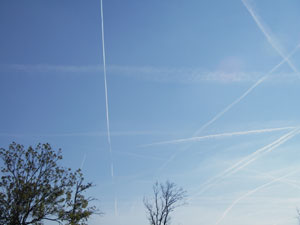 |
|
|
The river was meandering as we neared the end of it and we were also meeting more barges now. According to our guide book there should be a fuel barge just before the two rivers met. We were keeping a sharp look out between the increasing traffic and spotted it at last. It was very tricky mooring to the barge owing to the strong current and the increasing wind – but we made it at last. Then we found out that he only had red diesel which is for commercial vessels only. Nothing else for it but to cast off again.
|
 |
|
|
We turned left onto the Seine. It was a lot larger than we had imagined. We now knew that we were going upstream (!) and you could really feel it in the boat too. According to the guide book there should be a mooring place in La Frette sur Seine. We found it without any trouble and even if it wasn´t late in the day, we decided to stay the night there. Reason being that we wanted to get into Paris in daylight. Another reason was that our Belgian friends told us that people had thrown stones at them in the suburbs of Paris. As they have a motor boat, they were indoors luckily. We were hoping that they wouldn´t throw stones in the day time. Here in La Frette we bought diesel from an ordinary petrol station and filled up. Our trolley came in very handy again as we had to walk a few kilometers. |
 |
|
|
It was a bitterly cold morning when we set off in the icy wind. On the map it doesn´t look too far, but in reality it is 74 km as the river meanders a lot. It was afternoon as we got into the suburbs of Paris. We had a few butterflies in the stomach, but nobody threw stones at us. Nevertheless, there were many who slept under the bridges. I didn´t take any pictures of them…
|
No picture. | |
|
The area became more densely populated and now we started to look out for known landmarks…and at last we saw it – the Eiffel Tower. It took a while before we got closer.
|
 |
|
|
It felt really exciting traveling in the middle of Paris. There was a lot of traffic. There were barges, boat buses and sight seeing boats. The river was very choppy and we were lucky we had two pairs of eyes to keep a look out. There were a lot of islands in the Seine – here in Paris as well. We were approaching one and suddenly she stands before us – the Statue of Liberty. Very beautiful and with an appropriate message.
|
 |
|
|
We carried on up the river looking for the guest harbour at Champs-Elysées and got very near to the Eiffel Tower.
|
 |
|
|
We didn´t find the guest harbour so we turned back – we must have missed it somewhere. But, no, the fact was that it wasn´t there at all.
We turned back up the river again – passed Notre Dame and ended up outside Port de Plaisance de Paris Arsenal. Two pleasure boats, who turned out to be British, were circling outside waiting to get into the lock. We decided to go into this guest harbour as well and after a while it was our turn to get through the lock. When we got in we realized that the guest harbour is just by the Place de la Bastille. A very safe port where the gates are locked in the evening and a guard patrols the port at night. We also found washing machines, showers, electricity and water. And free Internet! It is called WI-FI Paris. As we checked in we enquired about the cost for a winter place here. Very reasonable we thought and decided to stay.
We have decided to stay here until the end of March when we are continuing our journey down to the Mediterranean.
|
 |
|
|
A little food for thought: A lot of things have happened on our way here with a lot of challenges to contend with. And we have managed them! It feels very satisfying and you can´t help but think: “Imagine – we have done it!” Another confirmation of my motto: You will see it when you believe it! How has our relationship fared? Well, we are still speaking to each other. But during the trip we have talked a lot about communication. Most important in various situations where immediate action is needed. Has the message reached the recipient? Have we understood what the other one means? Above all, have we heard what the other one is saying? Sometimes the response has been: “You don´t have to nag! I heard you the first time!” The agreement is that you have to confirm that you have heard what the other one has said. Who is responsible if somebody does not understand what the other one means? Or is it that you are just stupid? The agreement is that the responsibility lies with the person submitting a message to do so, in such a way so that it is understood. Then there is the question of memory. In connection with this we would like to share the following story with you: An old couple is sitting on their patio enjoying the sunshine. The wife says to her husband: “It would be nice with some ice cream”. Husband: I will get some ice cream for you”. Wife: Wouldn´t it be an idea to write it down on a piece of paper. You know what you are like remembering”. Husband: “No, it´s alright – I´ll remember.” Wife: “It would be nice with some strawberries as well…and a wafer”. Husband: “OK”. Wife: “Shouldn´t you write it down anyway?” Husband: “ No, no. I´ll remember: Ice cream, strawberries and a wafer” No problem”. The husband was away for quite a while before he came back. He presented his wife with a plate of bacon and eggs. The wife looks at the plate for a while and then exclaims: “ And where is my toast?” We wish everybody a Merry Christmas and a Happy New Year!
(We will return in the spring)
|
||
|
|
||
|
|
||
|
|
||
|
|
|
|
|
I
|
||
